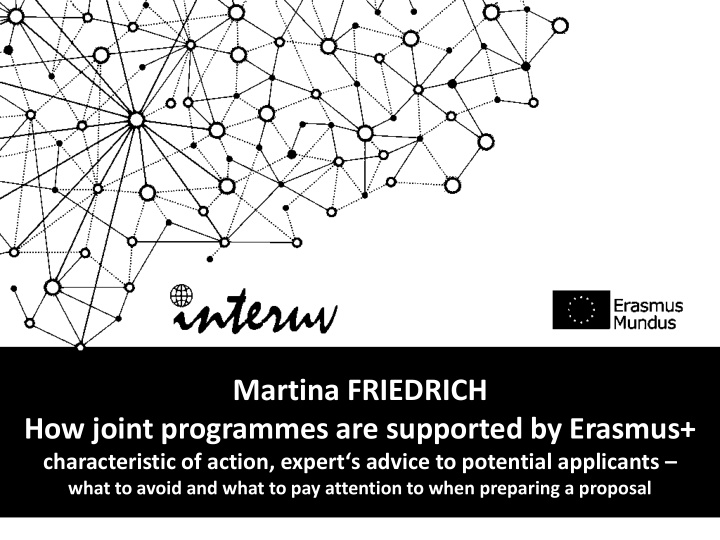



Martina FRIEDRICH How joint programmes are supported by Erasmus+ characteristic of action, expert‘s advice to potential applicants – what to avoid and what to pay attention to when preparing a proposal
Joint int Degree ee Mobil ility ity … formerly ERASMUS MUNDUS Master Courses Consortium: minimum of 3 HEI from 3 different Programme Countries (= EU28, Iceland, Liechtenstein, Norway, Switzerland, FYRo Macedonia, Turkey) positive: integration of HEI from Partner Countries positive: businesses / companies / research centres for placements Consortium offers joint curriculum to excellent students coming from the whole world Students have to study at min. 2 of the HEIs from Programme Countries and will receive a Double / Multiple / Joint Degree
Capacity acity Building ding … formerly TEMPUS, ALFA, EDULINK, ASIA LINK Consortium: minimum of 3 HEI from 3 different Programme Countries (= EU28, Iceland, Liechtenstein, Norway, Switzerland, FYRo Macedonia, Turkey) and minimum of 2 HEI from each Partner Country involved (= about 150 countries: Southern & Eastern Neighbourhood Countries, Western Balkan*, Asia*, Latin America*, Countries of the African-Caribbean-Pacific Group, Iran, Iraq, Yemen for Structural Projects: additionally ministry from Partner Country positive: businesses / companies / research centres / … Activities: Joint Projects (e.g. curriculum development) Structural Projects (e.g. modernisation of governance at HEI) additionally for projects with Neighbourhood Countries: Mobility Component
Prepar paration tion of a proposal osal Read carefully: the programme guide of Erasmus+ the relevant call for proposals the actual application form if you already know the former programme generation: there are changes! the summaries / homepages of already funded projects in similar (academic) fields from the former programme generation are useful Contact your Erasmus+ National Agency / National Office* (former EM-NS, TEMPUS NCP / NTO): Participate in (inter-)national info days and regional workshops Discuss your project idea and ask for advice
Project ject idea Make sure that your project idea, the content, the targets and the beneficiaries match with the objectives of the programme Identify the correct action and check possible priorities, e.g.: • academic fields, thematic topics, regions, target groups like minorities Decide which role you like to take over in the project, esp. applicants need the administrative and financial capacities for realizing the project Will you have the support of your HEI? Is your project innovative enough? Depending on the action, e.g.: • academic field, (non-)academic partners, mobility tracks, labour market • products, results, measures Check the legal requirements, e.g.: • ECHE, diploma supplement, joint degrees, tuition fees
Partne tnershi ship Respect the minimum number of partners Check the eligibility of your partners (e.g. ECHE) Reflect on the size and capacities of your consortium Think about the participation of and support from companies for : • placements, thesis • additional financial support like scholarships Complementarity between the partners: role and responsibility of each partner should be clear for having an added value Ensure institutional commitment of all partners Do you have the best team on board? Do you know your partners long enough?
Start t think nking ing about t your r applica cation tion now! Have your project idea clearly in mind before starting to write your application Plan face-to-facel meetings with the academic and administrative staff during the preparation phase Each partner should be actively involved Inform partners early enough which figures / documents / signatures you need Set up an activity plan with milestones Is there a weakest link? Do you need an “exit solution”? Start to write your proposal 3 months before the deadline Write it in a clear, short and easily understandable way. Have it checked by someone who speaks the mother tongue of your proposal
The propos posal al (1) Find a meaningful and informative project name and acronym for marketing! Present your project in a detailed, coherent and broad way Explain the demand of your project very detailed for all beneficiaries, e.g.: • HEI, students, labour market, society Present a detailed dissemination and sustainability strategy: • Can you transfer the project/results to similar academic fields / other HEI/regions? If required: project duration: realistic time schedule depending on workload Financial plan has to reflect partners’ participation – has to be transparent and detailed Calculate enough own/other funds – explain the financial sources
The propos posal al (2) The applicant is mainly responsible for the management! • Plan milestones in your project (e.g. meetings, reports, presenting results) • Divide the responsibility between the partners or the different boards • Applicant is responsible for accounting, funding and controlling • Applicant has to write the interim and final reports to the EACEA Evaluation, quality control, monitoring and audit are very important instruments! Internal (trough the consortium) and external (trough independent experts) The summary (!!!) has to be complete (sum-up the whole project) and very well formulated In general don’t forget keywords like: ECTS, diploma supplement, double/joint degrees, recognition/accreditation, integration, institutional commitments, added value, quality assurance, dissemination, sustainability, employability, visibility, transparency, …
Helpful pful sources ces When preparing the proposal: Use additional documents from the EACEA homepage like model agreements, financial and administrative handbooks or expert assessment manual Esp. for the preparation of Joint Degree Mobility Projects: http://emap-project.webnode.cz: ERASMUS MUNDUS funded the project EMAP: Training workshops of ERASMUS MUNDUS National Structures – tips and best practices http://www.joiman.eu: Guidelines and good practice examples on the administrative issues related to Joint Degrees’ management http://www.emqa.eu: Handbook of excellent higher-education practice - interactive tool to assess your own course http://www.enic-naric.net: Network for recognition of academic & professional qualifications http://www.ecaconsortium.net: European Consortium for Accreditation in HE: Mutual Recognition of Accreditation Results regarding Joint Programmes http://www.qrossroads.eu/about-qrossroads?Source=/default.aspx: Qrossroads presents information regarding quality assured and accredited HE in Europe
Tha hank nk you ou and nd good luck !!!
Recommend
More recommend